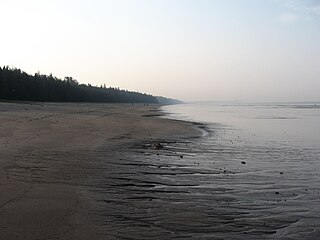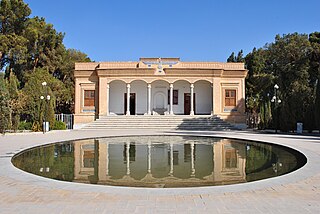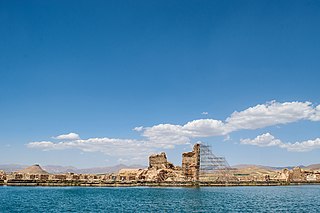
The Parsis or Parsees are an ethnoreligious group of the Indian subcontinent adhering to Zoroastrianism. They are descended from Persians who migrated to Medieval India during and after the Arab conquest of the Persian Empire to escape religious persecution. Parsis are the older of the Indian subcontinent's two Zoroastrian communities, the other being the Iranis, whose ancestors migrated to British-ruled India from Qajar-era Iran.

Jadi Rana was an Indian ruler of Sanjan, Valsad in present-day Gujarat as per the Qissa-i Sanjan, an epic poem completed in 1599, which is an account of the flight of some of the Zoroastrians who were subject to religious persecution following the fall of the Sassanid Empire, and of their early years in India, where they found refuge. A 20th-century translation of the Qissa transliterates the name as Jádi Rana.

A fire temple or agiary is the place of worship for the followers of Zoroastrianism, the ancient religion of Persia. In Zoroastrianism, atar or fire, together with aban, water, are agents of ritual purity. Clean, white "ash for the purification ceremonies [is] regarded as the basis of ritual life", which "are essentially the rites proper to the tending of a domestic fire, for the temple [fire] is that of the hearth fire raised to a new solemnity". For, one "who sacrifices unto fire with fuel in his hand ..., is given happiness".

Sexual orientation in Zoroastrianism is, as in many other religions, a controversial topic with differing consensus over time.
Navsari is the ninth biggest city in the state of Gujarat in India. It is the administrative headquarters of Navsari District. Navsari is situated between Surat & Mumbai. Navsari is a twin city of Surat. It is located 37 km south of Surat. As per 2011 Census of India, Navsari is 16th biggest city of Gujarat state. It ranked 10th most populous city of Gujarat in 1991 Census of India and 2001 Census of India. Navsari is the 25th cleanest city of India according to the Swachh Bharat Urban mission. Dandi village near Navsari was the focal point of the great Salt March led by Mahatma Gandhi during civil disobedience movement of India.

Valsad district is one of the 33 districts in the Western Indian state of Gujarat. It is bound by Navsari district to the north, Nashik district of Maharashtra state to the east, and Dadra and Nagar Haveli district of the Dadra and Nagar Haveli and Daman and Diu (DNHDD) union territory and the Palghar district of Maharashtra to the south. The Arabian Sea lies west of the district. The coastal Damaon enclave of DNHDD is bounded by Valsad district on the north, east, and south. The district's administrative capital is Valsad. The district's largest city is Vapi.
Ervad Godrej Sidhwa was born in Karachi, Pakistan, and studied the Avesta, Pahalvi, Persian, & Pazend languages, as well as Ancient Iranian literature at M.F. Cama Athornan Institute, Andheri, Mumbai, for six years. He was initiated into the Zoroastrian priesthood by going through the Navar and Maratab initiation ceremony from Iranshah Atash Behram, Udvada, India. His initiation as a priest accounts for the "Ervad" ('Reverend') title.

The Story of Sanjan is an account of the early years of Zoroastrian settlers on the Indian subcontinent that was originally written in 1599 CE by Parsi priest, Bahman Kaikobad. In the absence of alternatives, the text is generally accepted to be the only narrative of the events described therein, and many members of the Parsi community perceive the epic poem to be an accurate account of their ancestors.

Maneckji Limji Hataria (1813–1890) was an Indian scholar and civil rights activist of Parsi Zoroastrian descent, who took up the cause of the Zoroastrians of Iran.
Udvada is a town situated in Pardi taluka in the Valsad district in the state of Gujarat, India. Udvada is a coastal town located around 24 km from the Valsad city. The Zoroastrian temple, Udvada Atash Behram is situated here.

Nargol is a village located in the Indian state of Gujarat.
The first Dastur Meherji Rana, sometimes known as Mayyaji Rana, was a spiritual leader of the Parsi community in India during the sixteenth century. He was seen by the Parsi community as someone with “vast knowledge and spiritual powers”.
An Atash Behram is the highest grade of fire that can be placed in a Zoroastrian fire temple as an eternal flame. The other two lower graded fires are Atash Adaran and below Adaran is the Atash Dadgah; these three grades signify the degree of reverence and dignity these are held in. The establishment and consecration of the Atash Behram fire is the most elaborate of all the grades of fire. It involves the gathering of 16 different types of fire, including fire by lightning, fire from a cremation pyre, fire from trades where a furnace is operated, and fires from the hearths as is also the case for the Atash Adaran. Each of the 16 fires is then subject to a purification ritual before it joins the others. A large team of priests are required for the purification and consecration ceremonies, which can take up to a year to complete.

Jamshedji Sorab Kukadaru was a Zoroastrian priest in Mumbai, India. He was revered by Zoroastrians for a number of miracles he is believed to have performed. He was well known by his contemporaries for his simple lifestyle and asceticism, as well as his unflinching adherence to priestly purity rules. Most of his life is said to have been spent in prayer.
Bahrot Caves, locally known as Barad, near Dahanu, Maharashtra are the only Parsi/Zoroastrian Cave temple in India. Bahrot Caves is located 25 km south of Sanjan, Gujarat and are situated at a small distance of 8 km away from the village of Bordi also nearly 9 km from NH48 from Talasari.

The Fire Temple of Yazd, also known as Yazd Atash Behram, is a Zoroastrian fire temple in Yazd, Yazd province, Iran. It enshrines the Atash Bahram, meaning “Victorious Fire”, dated to 470 AD. It is one of the nine Atash Bahrams, the only one of the highest-grade fires in Iran, where Zoroastrians have practiced their religion since 400 BC; the other eight Atash Bahrams are in India. According to Aga Rustam Noshiravan Belivani, of Sharifabad, the Anjuman-i Nasiri opened the Yazd Atash Behram in the 1960s to non-Zoroastrian visitors.
Fire is one of the elements that was praised and venerated by the ancient Iranians. Fire is in the Avesta as Atash or Atar, in Pahlavi literature atour or atakhsh; or in Persian literature, fire is known as azar or athash. The guardian angel of fire is known as Atouryast in Pahlavi literature, and in Persian literature Azarizad. Due to the importance of the position, the Angel has been called the son of Ahura Mazda refer the Khordeh Avesta- Atash Niyash, litany to fire where Atash is called the son of Ahura Mazda. In ancient Iranian ritual, in order to appease the fire angel, fragrant woods or sandalwood were constantly applied in fire temples and fires in homes, this is done to this day, in over 300 consecrated Fire Temples like Udvada Atash Behram by Parsis and Iranian Zoroastrians. In the religion of Zoroastrianism, fire is a sign of purity and truth, and Ardibehesht is its guardian. Ancient Iranian legends attribute the discovery of lighting a fire with two stones to King Hushang of Pishdadian dynasty. The tradition also survives in Sadeh celebration, which still makes it popular.
There was communal violence between Parsis and Bharuchi Sunni Vohra Muslims in May 1857 in Broach in India.

Adur Gushnasp was the name of a Zoroastrian sacred fire of the highest grade, which served as one of the three most sacred fires of pre-Islamic Iran; the two others being the Adur Farnbag and Adur Burzen-Mihr. Out of the three, Adur Gushnasp is the only fire whose temple structure has been discovered and "for which archaeological, sigillographical, and textual evidence are all available."

Sharifabad is a neighborhood of the city of Ardakan in the Central District of Ardakan County, Yazd province, Iran. Sharifabad is one of the Zoroastrian centres of Iran, home to numerous Zoroastrian holy sites. Every summer, thousands of Zoroastrians from around the world gather here on pilgrimage.



















